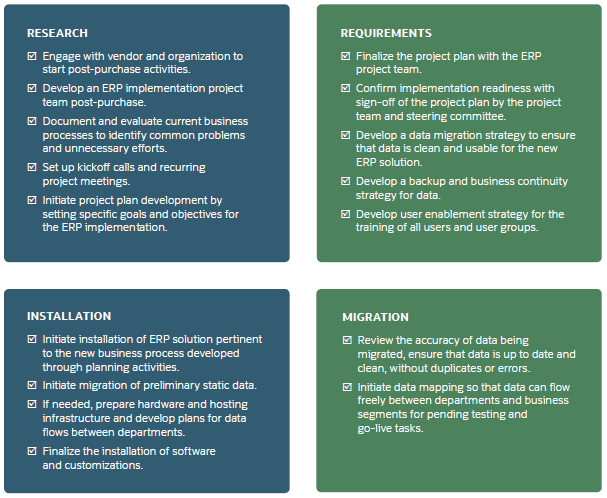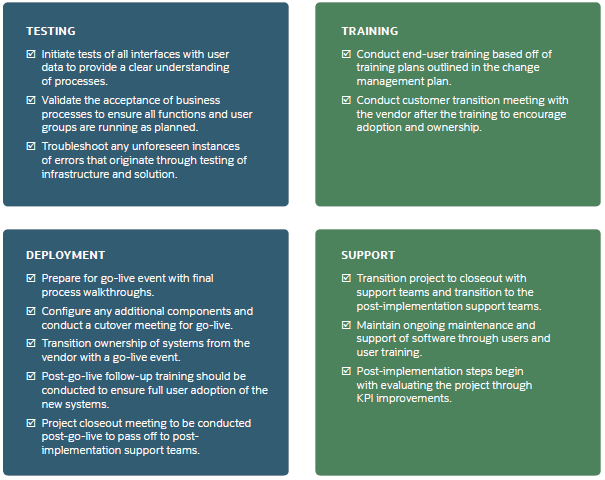Implementing an enterprise resource planning (ERP) system can be a complex undertaking that affects many parts of a business. As with any major initiative, a carefully designed plan is critical. Dividing your implementation into phases, each with clear objectives, can maximize your success.
In contrast, diving into an ERP implementation without first establishing clear project direction, scope and structure increases the likelihood of encountering significant problems later.
An ERP system integrates many functions across the business, such as financial management, human resources (HR), sales and marketing, and manufacturing, to deliver numerous benefits, including increased productivity and efficiency. ERP implementation describes the process of planning, configuring and deploying an ERP system. Because an ERP system supports and automates many different functions, the process takes most businesses at least a few months.
To ensure a successful implementation, carefully define company requirements, determine where you should redesign processes to take advantage of the system and where it’s best to configure the ERP system to support existing processes, and then rigorously test it before employees start using it. Successfully navigating all those steps on schedule requires careful planning and a structured, phased approach.
The 5 Stages of an Implementation Plan
A typical ERP implementation plan can be divided into five phases, each with specific objectives. The phases may vary somewhat depending on the company, and there could be some overlap between them.
1. Discovery and Planning
Every ERP project starts with a discovery and planning phase, which includes researching and selecting a system, setting up a project team and defining detailed system requirements.
2. Design
The design phase uses a list of requirements and current workflows to develop a detailed design for the new ERP system. This includes designing new, more efficient workflows and other business processes.
It’s important to involve users in the design phase to leverage their intimate understanding of current business processes and to ensure they’ll adopt the new system.
Businesses should conduct gap analysis to address uncommon needs that may require customizing the ERP software or modifying processes. The team can present the gaps to its implementation partner or supplier and ask them to identify potential solutions.
3. Development
Armed with clear design requirements, the development phase can then begin. This may involve configuring and customizing the software and integrating the platform with the organization’s other existing business applications. If you’re using an on-premises ERP system, the organization will also need to have purchased and installed the necessary hardware and software.
Meanwhile, the team should develop training materials for the new system. Begin planning data migration, which can be complex since it often involves extracting, transforming, and loading data from multiple systems, each of which may use different formats or hold duplicate or inconsistent information. The project team should determine which data to migrate in this phase, avoiding the blanket migration of all historical data, a lot of which is likely irrelevant (more on this below).
4. Testing
Testing and development may occur concurrently. For example, the project team may test specific modules and features, develop fixes or adjustments based on the results and retest. Or they may test one ERP module while another is still in development. Initial testing of the software’s basic functions should be followed by rigorous testing of the system’s full capabilities.
Most vendors can supply pre- and post-deployment resources to begin user training. But the organization should also make good use of the training materials created in the development phase. There is real value in resources that specifically cater to the use cases of different employees.
5. Deployment
Be prepared for potential issues in deployment since there are plenty of moving parts and possibly some befuddled employees, despite your best efforts to prepare them for the change. The project team should be readily available to answer questions, help users understand the system and attempt to fix any issues.
Some data can be migrated before deployment, while other information — such as current transactions — should be migrated immediately before going live. There are several different approaches to deployment, which we’ll cover in detail later.
Build the Right Implementation Team
Establishing a strong project team is critical. The team’s responsibilities involve establishing top-level goals, requirements and key performance indicators (KPIs), conducting day-to-day project management, ensuring that the project stays on time and on budget, and measuring results.
During the implementation, the team must be able to resolve conflicts and mediate between different groups within the organization. They may also need to make decisions regarding midstream changes to the ERP implementation strategy based on user feedback and input.
Each team member should have clearly defined roles and responsibilities based on their areas of expertise and how much time they can devote to the project.
Executive Sponsor
Every project needs an executive sponsor — someone at or near the top of the company who will champion and drive the implementation strategy. The executive sponsor helps assess risks, devise action plans and often serves as the company cheerleader and face of the project. During the implementation, the executive sponsor receives updates from the project manager and sometimes from core team members.
The executive sponsor typically makes final decisions about the project, balancing input from the implementation team with customer needs. These decisions may include whether to increase the project budget, which business processes to automate and whether to add or remove personnel.
Project Manager
Any ERP implementation needs a point person who makes sure timelines are met and the project stays within its planned scope. The project manager is that person and is often someone from the finance or IT department, depending on the project focus.
The project manager typically selects a few different ERP vendors, schedules demos for the team and organizes the final evaluation. They also coordinate all the steps of the implementation, including mapping the system to business processes and testing. At each stage, the project manager will update the project plan and serve as the liaison between the executive sponsor and the team members.
End User
The end users on an ERP implementation team, some of whom are super users that have a deeper understanding of the system’s capabilities, will raise any concerns their departments have about the system design. They can encourage adoption and help with training and troubleshooting within their department.
End users need to have leadership skills to champion the project with other colleagues, as well as decent technical and communication skills.
Core Cross-Functional Team Members
In addition to end users, the team will need technical experts from different areas of the business, like finance, IT, manufacturing, sales and marketing, HR, etc. These team members are responsible for helping direct software design and configuration to support their business processes and identifying ways to support those processes with the new system. They usually need to learn some of the technical aspects of the ERP software to better understand how it can address different business needs and help users with technical issues.
If the organization does not use the ERP vendor’s services team or a third-party partner to lead the implementation, the IT team member will also represent the internal IT staff responsible for getting the system live.
Report Writer
A key part of the value of an ERP system is the ability to generate reports that provide analysis and insights on every aspect of the business. Traditionally, report writers came from the IT department since they needed technical skills to customize the software’s reports. However, that’s changing, and report writing could fall on a member of the accounting or finance team.
At the very least, reports should include substantial input from the finance team since they will be using the reports and know what information they need. That person must develop a detailed knowledge of the ERP system’s reporting tools and the data the system stores.
The report writer’s responsibilities include analyzing the organization’s existing reporting procedures and developing ways to enhance them with the new solution. They may continue to be involved in modifying and creating new reports after the system goes live.
End users need to have leadership skills to champion the project with other colleagues in addition to competent technical and communication skills.
Implementation Partner
Companies often use an implementation partner to handle the technical work involved in deploying the system and reduce the responsibilities put on the internal team. For example, an implementation partner can act as the project manager and coordinate the technical aspects of system customization and installation.
Identify the Best Implementation Strategy
There are several proven strategies for moving to a new ERP system, each with distinct advantages and disadvantages. Let’s walk through four of the most common approaches.
1. Big Bang
In this approach, also referred to as the “single-step method,” all users move to the new system at the same time. You’ll need to have completed all configuration and testing of the new system, along with training, by the go-live date.
The advantage is that you quickly start realizing ERP benefits, such as higher productivity, better insights and lower operating costs. However, once you’ve rolled out the system, it’s hard to go back, so it’s critical to get things right. Any error or glitch — even a relatively minor one — can impact employees, business partners and customers. There may also be a temporary productivity drop as employees adjust to the new system.
2. Phased Rollout
With a phased rollout, the deployment of features, tools and components is done over an extended period, which may cover weeks or months. This more measured approach can be less risky than the big-bang strategy. It also enables the company to focus first on “quick wins” and apply lessons from the initial deployment phases to subsequent phases.
There are three primary strategies within phased rollout. Organizations may switch on one ERP module, iron out bugs and process issues, and then tackle another module. Another option is to deploy by business unit, such as HR or operations, and then move forward based on needs. The third approach is to break up the rollout by geography, testing and refining the system at one location before moving on to other offices, factories or facilities.
But there are drawbacks to a phased rollout: It takes longer to get the full benefits of the new ERP, and your company will need to support and pay for two systems (the old one and the new one) at the same time.
3. Parallel Adoption
With this strategy, the organization keeps using its old systems in parallel with the new ERP for a specific length of time. This is generally considered the least risky approach because of the inherent safety in redundancy, especially in protecting critical functions that must continually operate.
This approach also facilitates a gradual adoption process for users. However, parallel adoption can be an expensive approach because it requires more staff time and resources to keep two systems running simultaneously. And parallel adoption is not risk-free — entering data twice, into two different systems, doubles the chance of errors.
4. Hybrid
As the name implies, this approach combines elements of the strategies above. For example, an organization might switch on core ERP modules using a big-bang strategy, then roll out other modules in phases to specific locations or departments.
Plan for Common ERP Implementation Challenges
A successful ERP implementation requires contributions from several people, so it often faces challenges such as resistance to change and technical obstacles. Common ERP implementation challenges include:
Project Management
As noted earlier, ERP implementations entail multiple phases. Each phase brings critical tasks, and all elements need to stay on track, so meticulous project management is critical. Successful ERP implementations also require participation from all the groups that will be involved in developing and using the system. That can be incredibly challenging because each department is juggling its ERP project responsibilities with multiple other priorities.
Strong project and people management, which includes setting realistic expectations, deadlines and milestones, along with timely two-way communication, is crucial to success.
Project Planning
Organizations often underestimate the time and budget necessary for a successful implementation. Two of the most common causes of budget overruns are scope creep — when a business adds capabilities or features to the system that weren’t part of the original plan — and underestimating staffing needs.
A realistic project plan that acknowledges possible speed bumps and minor cost overruns and addresses them in advance will simplify decision-making processes and keep the project on track.
Data Integration
One of the key advantages of an ERP system is that it provides a single, accurate source of data for the whole organization. A key step in ERP implementation is data migration, which typically involves transferring and consolidating data from multiple systems into a central database.
But first, you must find all your data. This may be much more challenging than you expect. The information may be spread far and wide, buried in accounting systems, department-specific applications, spreadsheets and on paper.
Well-planned data migration can help keep the entire ERP implementation project on time and within budget. It’s also an opportunity to winnow out obsolete and redundant data lurking in the organization’s older systems. In contrast, underprioritizing data migration can cause issues such as inaccurate or duplicate data and go-live delays.
Data Quality
Once the organization has located all data sources, it can start planning how to migrate it to the ERP system. But that may involve a serious data hygiene exercise. Because multiple departments interact with the same customers, products and orders, organizations often have duplicate versions of the same information in their systems. Information may also be stored in different formats or contain other inconsistencies.
New data should also be thoroughly tested before going live with the ERP system. Make sure your team understands the importance of cleaning up data and assign clear responsibilities for doing so. For example, the accounting team will clean all financial data and the customer service group will handle customer data.
Change Management
As part of an ERP implementation, many organizations overhaul business processes to increase efficiency and reduce costs. Employees must not only learn how to use new technology but may also have to adapt to new work processes that change their day to day.
Resistance to change can be a formidable roadblock, but getting buy-in from leadership and stakeholders across departments early in the process should reduce resistance. Communicate the features and advantages of the new ERP to all stakeholders throughout the implementation, especially end users. And make sure all users receive comprehensive training and support to ease their paths to adopting the system.
Cost Overruns
ERP projects are infamous for sailing past budgets after the implementation kicks off. Many organizations underestimate the amount of work required to move to a new business system, and that results in spending more money than expected.
When internal resources run low, businesses frequently turn to a software vendor’s services team or third-party consultants. This is especially common if the solution requires significant customization to meet your company’s needs. Experienced ERP consultants usually run about $150-200 per hour, plus travel expenses. Another budget breaker is data migration, which can represent 10%-25% of the total project cost. Training costs are one other expense to consider — ERP vendors often offer free basic training to customers, but you may need to pay for additional training hours or classes during or after the implementation.
To avoid blowing up the budget, companies should consider these and other overlooked expenses, and budget more than they think for them. Coming in under budget is always preferable to the alternative.
Stick to an Implementation Checklist
Any efficient ERP implementation plan requires a roadmap, which often comes in the form of a checklist of tasks that helps keep the project moving along, from pre-implementation activities, like research and requirements building, to final implementation phases, like maintenance and support.
Both the customer and vendor need to work through each step on the checklist to ensure a smooth project.
ERP Implementation Checklist


A Better Implementation Approach
One way to reduce the challenges that come with an ERP implementation is to follow an implementation model designed specifically for your industry. NetSuite’s SuiteSuccess implementation methodology takes advantage of the company’s deep industry experience and tens of thousands of implementations to deliver a strategy tailored to your business.
SuiteSuccess offers prebuilt workflows, KPIs, reports and dashboards specific to certain verticals and company sizes.
This proven methodology prevents common implementation roadblocks, like long deployments that lead to ballooning costs, major business disruption and employee fatigue. Ultimately, SuiteSuccess helps businesses realize the value of their ERP more quickly.
Implementing an ERP system can be a complex undertaking and affects many parts of a business. All five phases of a typical ERP implementation have specific objectives, although they may vary slightly from one company to another. Successfully navigating the steps and deploying a platform on schedule requires careful planning and an organized, phased implementation approach.
Project leaders must carefully define company requirements, determine how to redesign processes to take advantage of the system, configure the software to support those processes and rigorously test it before going live. Following the steps and tips highlighted in this business guide will help make your ERP journey a success.
Need Help?
If you’re interested in SuiteSuccess to implement NetSuite and enhance your organization’s processes, contact us online, give us a call at 410.685.5512 or click the link below to schedule your demo.



